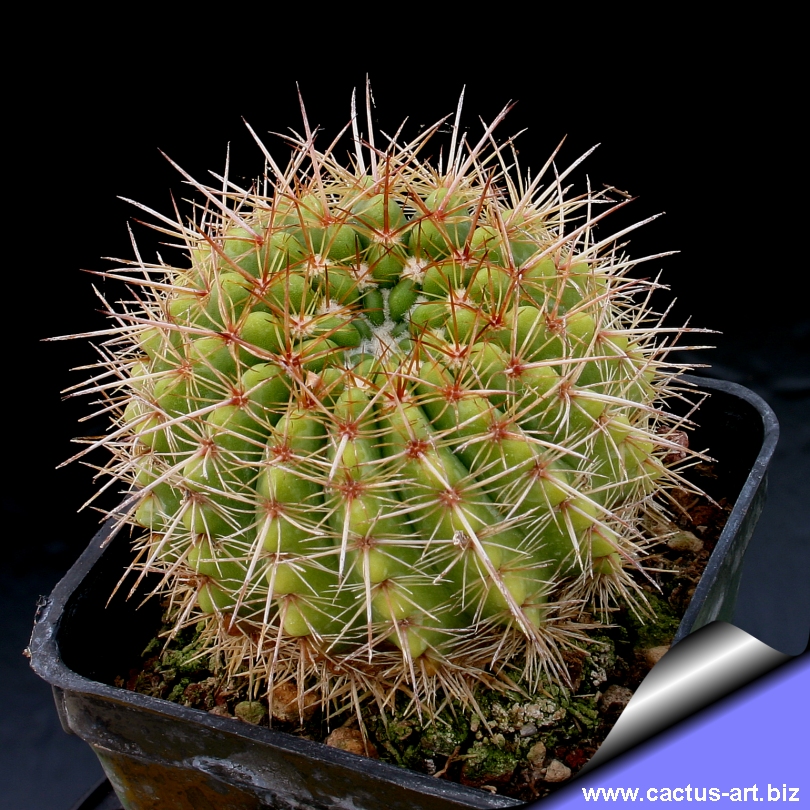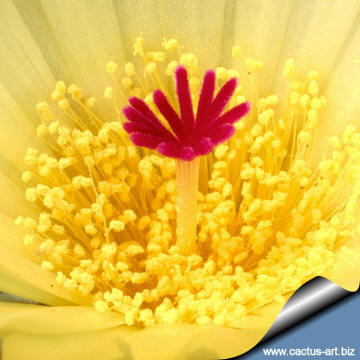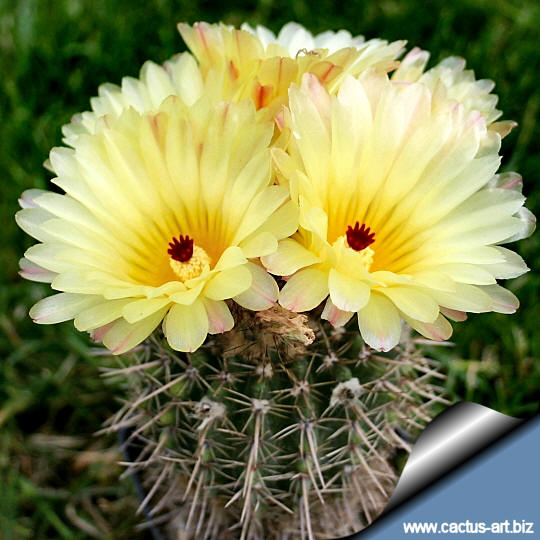|
|
|

Parodia
mammullosa ssp. mammulosa
|
|
NOTE:
Parodia (Notocactus) mammulosa are
among the the most wide-spread of the Parodia species and are
very variable in appearance. The P. mammulosa
complex
comprises lots of names and lots of different
population. Plants may differs considerably about the form and
arrangement of the spines, stems, ribs and flowers colour with unclear
morphological limits between the different forms.
|
 |
Description:
Parodia mammulosa (sensu
lato) is a usually solitary cactus more or less covered by
interlacing spines.
Stem: Globose, that elongates to a height of 5-10 cm and a
diameter of 7-13cm with a depressed, spineless apex. The epidermis is
shiny, greysh-green to dark green,.
Ribs: 18 to 20(-25) straight, well distinct, with prominent,
rounded tubercles with chinlike protrusion.
Areoles: Small or large deeply embedded between the tubercles
and set about 5 mm apart.
Radial spines: 8 to 30 slender whitish to brownish, needlelike,
usually less than 10 mm long.
Central spines: 1-4 (or more) up to 20 mm long, not easily
distinguishable from the radials, usually flattish, thicker, straight
and more than twice as long white, yellow to brown with a brown tip,
one usually flattened.
Flowers: Pale pink to golden yellow beautifully emphasized by the
purplish/red stigma lobes, 4 cm in diameter, with a short tube covered
with white wool and brown bristles.
Fruit: Globose, elongating at maturity, thin walled.
Seed: Bell to helmet shaped, with obvious corky hilum, matte
brown. |
|
There are a
number of variety and forms of this highly variable cactus species, but
not all are universally recognized. Some authorities recognize the
following varieties:
Parodia mammullosa ssp. mammulosa
Plants have 18-25 ribs, 2-4 central spines and 20-30 radials It is
widely distributed in Brazil, Uruguay and Argentina.
Parodia mammullosa ssp. brasilensis They have about 15
ribs, 1 central spine, 8-10 radials, it occur near Santos, Brasil.
Parodia mammullosa ssp. erythracantha They have about 16
ribs, 2 central spines and 10-14 radials it occour in Tacuarembo,
Uruguay.
Parodia mammullosa ssp. submammullosa
These plants have the fewest number of ribs (about 13), about 6 radial
spines spreading out horizontally, and two long and flat central spines,
of which one longer and pointing down, and another a bit shorter and
pointing up, with a slender groove along their lower part. Spines are
yellow with a brown tip, the largest having a red base when young, later
turning gray.). It occours in Uruguai and argentina..
Cultivation:
This is an easy plant to cultivate. It
require a
mineral-based potting mix with a good
drainage.
Can support quite some water during the growing season
but pot plants in winter are
wet-sensitive and
needs to be kept
dry (rots easily if soil is wet and cold).
Usually it is recommended to
over-winter
this plant in a bright and warm greenhouse with at least 8-10° C ,
but it has
proved to tolerate temperatures as low
as -5° C for short periods.
Sun Exposure:
Light shade to
full sun but doesn't like
full, hot blazing sun in the central summer month.
Propagation: Seeds,
cuttings. Not too difficult to raise from seed.
|
|


Advertising
|
|
|
|
|
Family:
Cactaceae (Cactus
Family) |
|
Notocactus
mammulosus (Lemaire) A.Berger 1929.
Scientific name: Parodia mammulosa
(Lemaire) N. P. Taylor 1987
Tribe:
Cacteae subtribe: Echinocactinae
Origin: Parodia mammulosa
is distributed throughout southern Brazil, Uruguay and northern
Argentina
Conservation status: Listed in
CITES appendix 2.
Common Names include: Tom Thumb, Lemon
Ball.
Etymology: The name 'mammulosus'
refers to having many visible nipples.
|
Synonyms:
- Echinocactus mammulosus
Lemaire 1838
- Malacocarpus mammulosus
(Lemaire) Britton & Rose 1922
- Notocactus mammulosus
(Lemaire) A. Berger 1929
- Ritterocactus mammulosus
- Notocactus
rudibuenekeri
var. rudibuenekeri
- Parodia
rudibuenekeri (W. R. Abraham) Hofacker & P. J. Braun 1998
- Peronocactus
rudibuenekeri (Abraham) Doweld 1999 nom.gen.inval.
- Scopacactus
rudibuenekeri Abraham (nach Doweld 2000)
- Scopacactus
rudibuenekeri ssp. rudibuenekeri (nach Doweld 2000)
- Notocactus
scopa var. longispinus n.n. Lemaire 1838
- Notocactus
scopa var.
rudibuenekeri
|
Heterotypic synonyms:
- Notocactus mammulosus
var. brasiliensis Havlicek 1980
- Parodia mammulosa subsp.
brasiliensis (Hav.) Hofacker 1980
- Notocactus megalanthus,
- Notocactus ritteranus,
- Notocactus roseoluteus,
- Notocactus mammulosus
var.pampeanus,
- Notocactus submammulosus
var.pampeanus,
- Echinocactus pampeanus
- Notocactus pampeanus
- Notocactus
mueller-moelleri
- Ritterocactus megalanthus
- Echinocactus
hypocrateriformis
- Notocactus
hypocrateriformis
- Echinocactus floricomus
- Notocactus floricomus
- Notocactus cristatoides
- Notocactus
macambarensis
|
|
|
|
 |
Photo of conspecific taxa,
varieties, forms and cultivars
of
plants belonging to the Parodia
(Notocactus) mammullosa
complex
(This
Taxon has lots of
synonyms whit several controversial varieties and subspecies and
comprises a multitude of different forms, but where each form is linked
to others by populations of plants with intermediate characteristics):
|
|